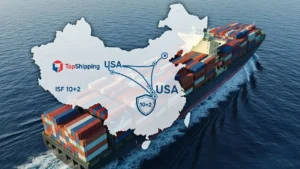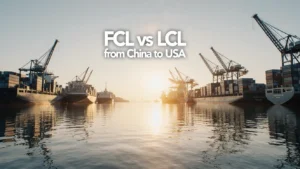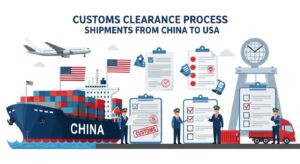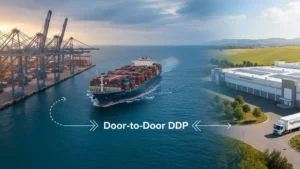What is a TEU? Definition and Standard Dimensions
TEU, or Twenty foot Equivalent Unit, is the standard measure used in maritime transport to quantify cargo capacity for container ships and ports. It represents a container that is 20 feet long, which serves as a reference point to compare different sizes of shipping containers. Understanding TEU is essential for shipping companies, freight forwarders, and logistics planners to calculate shipping rates, plan port operations, and optimize vessel loading.
TEU Meaning and Origin
The term Teu shipping originates from the practice of using a 20-foot container as the baseline unit in international shipping. It allows standardization across the global shipping industry.
While containers come in various sizes, including 40-foot containers, the TEU provides a consistent unit of measurement to assess cargo capacity.
For example, a 40-foot container equals 2 TEUs, making it easier for ports and shipping lines to calculate capacity utilization and freight costs.
This standardization became widely adopted after the container revolution in the 1950s, which transformed global trade by enabling faster and more efficient cargo handling.

Standard Size of a TEU Container
A standard TEU container has fixed dimensions that are widely recognized across the shipping industry:
- Length: 20 feet (6.1 meters)
- Width: 8 feet (2.44 meters)
- Height: 8.5 feet (2.59 meters)
The volume of a TEU container is approximately 1,360 cubic feet (38.5 cubic meters), although high-cube containers are slightly taller at 9.5 feet (2.9 meters) for additional capacity. These dimensions are critical for calculating port capacity, vessel loading plans, and freight charges, making TEU a universal benchmark in container shipping.
How TEU is Used in Shipping Calculations?
TEU is more than a measurement it is a key metric for logistical and financial planning in shipping:
Calculating Shipping Capacity: Shipping companies use TEU to determine how many containers a vessel can carry.
For example, a container ship with a capacity of 10,000 TEUs can transport either 10,000 20-foot containers or 5,000 40-foot containers (FEUs).
- Estimating Freight Costs: Freight rates are often quoted per TEU. This allows shippers to compare costs between routes and container sizes.
- Port Planning: Ports measure throughput and capacity in TEUs to optimize loading/unloading efficiency and infrastructure planning.
- Global Trade Analysis: International trade statistics frequently use TEU as a standardized unit to report containerized cargo volumes.
By using TEU as a common reference, the shipping industry ensures consistency, simplifies freight calculations, and improves operational efficiency across ports worldwide.
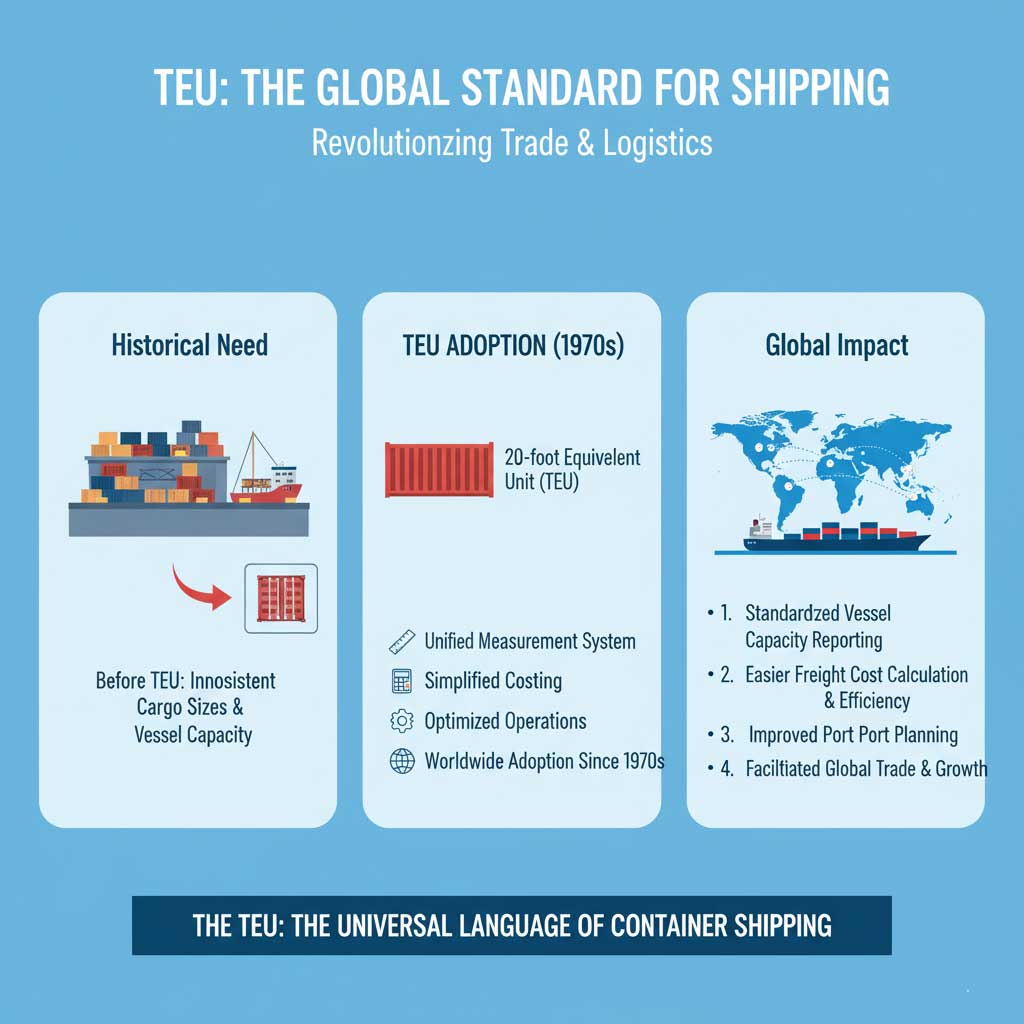
History of TEU and Standardized Containers
The concept of TEU and standardized containers revolutionized global maritime transport.
Before the adoption of standardized container units, cargo handling was slow, inefficient, and costly.
Understanding the history of TEU helps to appreciate its importance in modern shipping, port operations, and international trade.
Early Container Shipping
The first attempts at containerized shipping began in the mid-20th century, primarily in the 1950s.
Before this, goods were transported in break-bulk cargo, where items were loaded individually onto ships. This method was time consuming and prone to damage.
The introduction of standardized containers allowed cargo to be loaded, sealed, and transported without unpacking,
drastically reducing labor costs and transit times. Early container ships could carry a few hundred containers, but this innovation laid the groundwork for globalized trade.
Adoption of TEU as Standard Unit
As container shipping grew, the need for a standard unit of measurement became critical. The TEU (Twenty-foot Equivalent Unit) was adopted internationally to:
- Provide a consistent way to measure vessel capacity
- Facilitate freight cost calculations
- Simplify port operations and planning
By the 1970s, TEU had become the global standard. For instance, ports, shipping companies, and logistics planners worldwide began reporting cargo volumes in TEUs, making it easier to compare traffic, optimize shipping routes, and plan infrastructure investments.
Evolution of Container Sizes Over Time
Although the TEU is based on a 20-foot container, container sizes evolved to meet different shipping needs:
- FEU (Forty-foot Equivalent Unit): 2 TEUs, the most common container size today
- High-cube containers: Taller containers with extra height for lightweight, voluminous cargo
- Specialized containers: Refrigerated (reefer) containers, tank containers, and open-top containers
These innovations allow shipping companies to maximize vessel efficiency while transporting diverse types of goods.
However, TEU remains the primary reference unit for reporting capacity, freight rates, and port throughput, ensuring a consistent global standard.
Importance of TEU in Ship and Port Capacity
TEU plays a critical role in determining the efficiency of both ships and ports. By providing a standard measurement for containerized cargo, TEU helps shipping companies , port authorities, and logistics planners optimize operations, manage capacity, and reduce costs. Understanding TEU’s importance is essential for anyone involved in maritime transport or global trade logistics.
TEU and Cargo Ship Classification
Shipping vessels are often classified based on their TEU capacity, which directly reflects how much cargo they can carry. Examples include:
Feeder ships: 1,000–3,000 TEUs
Panamax ships: 4,000–5,000 TEUs, designed to fit the Panama Canal
Post-Panamax and Ultra Large Container Vessels (ULCVs): 10,000–24,000 TEUs
This classification allows shipping companies to choose the right vessel for specific routes and cargo volumes, optimize fuel efficiency, and plan port calls effectively. TEU also provides a common language for comparing vessel sizes across the industry.
Port Terminal Planning and TEU
Ports use TEU as a benchmark to plan terminal operations, including:
Berth allocation: Determining which ships can dock based on TEU capacity
Yard management: Organizing container storage efficiently
Throughput analysis: Measuring the number of TEUs handled over time to track performance
By standardizing cargo measurements, TEU enables ports to maximize efficiency, reduce congestion, and plan future infrastructure investments.
For example, major ports like Singapore, Shanghai, and Rotterdam report annual throughput in TEUs, which helps global logistics companies forecast shipping rates and transit times.
Impact on Global Trade Logistics
TEU is not just a unit of measurement it is a key metric in international trade. Its influence includes:
- Supply chain planning: Companies calculate the number of TEUs needed to move goods efficiently
- Freight cost estimation: Shipping rates are often quoted per TEU, simplifying budgeting
- Global trade statistics: TEU data helps governments and analysts track containerized cargo flows
Using TEU as a standard allows for accurate comparisons between ports, shipping routes, and container ships, making it essential for modern global trade
Importance of TEU in Ship and Port Capacity
TEU plays a critical role in determining the efficiency of both ships and ports. By providing a standard measurement for containerized cargo, TEU helps shipping companies, port authorities, and logistics planners optimize operations, manage capacity, and reduce costs. Understanding TEU’s importance is essential for anyone involved in maritime transport or global trade logistics.
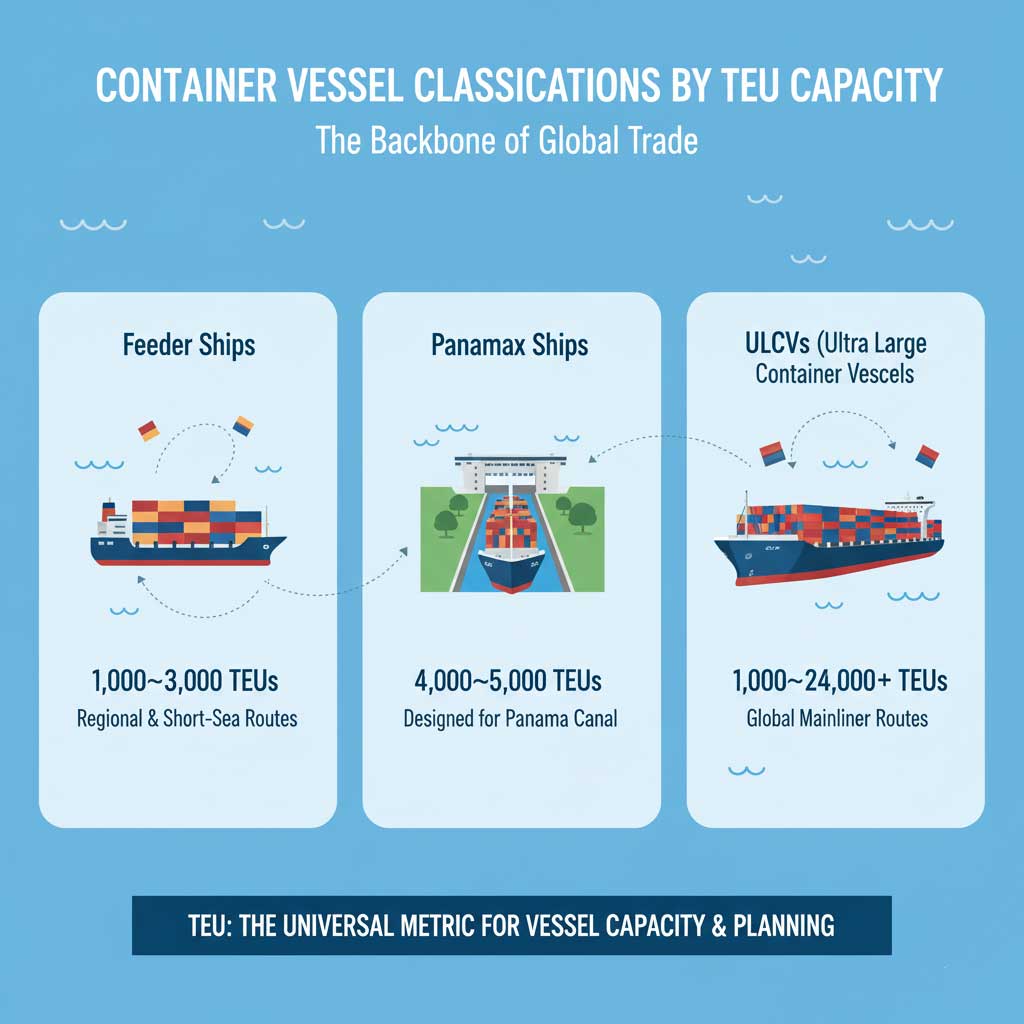
TEU and Cargo Ship Classification
Shipping vessels are often classified based on their TEU capacity, which directly reflects how much cargo they can carry. Examples include:
- Feeder ships: 1,000–3,000 TEUs
- Panamax ships: 4,000–5,000 TEUs, designed to fit the Panama Canal
- Post Panamax and Ultra Large Container Vessels (ULCVs): 10,000–24,000 TEUs
This classification allows shipping companies to choose the right vessel for specific routes and cargo volumes, optimize fuel efficiency, and plan port calls effectively. TEU also provides a common language for comparing vessel sizes across the industry.
Port Terminal Planning and TEU
Ports use TEU as a benchmark to plan terminal operations, including:
- Berth allocation: Determining which ships can dock based on TEU capacity
- Yard management: Organizing container storage efficiently
- Throughput analysis: Measuring the number of TEUs handled over time to track performance
By standardizing cargo measurements, TEU enables ports to maximize efficiency, reduce congestion, and plan future infrastructure investments.
For example, major ports like Singapore, Shanghai, and Rotterdam report annual throughput in TEUs, which helps global logistics companies forecast shipping rates and transit times.
Impact on Global Trade Logistics
TEU is not just a unit of measurement it is a key metric in international trade. Its influence includes:
- Supply chain planning: Companies calculate the number of TEUs needed to move goods efficiently
- Freight cost estimation: Shipping rates are often quoted per TEU, simplifying budgeting
- Global trade statistics: TEU data helps governments and analysts track containerized cargo flows
Using TEU as a standard allows for accurate comparisons between ports, shipping routes, and container ships, making it essential for modern global trade.
Comparing TEU with FEU and Other Container Units
Understanding TEU in relation to FEU and other container units is essential for accurate shipping calculations and logistics planning. While TEU is the baseline measurement, knowing the differences between container units allows shipping companies, freight forwarders, and ports to optimize capacity and estimate costs effectively.
What is an FEU?
An FEU (Forty-foot Equivalent Unit) represents a 40-foot container, which is equivalent to 2 TEUs. FEUs are widely used in modern shipping because many ocean container vessels and ports are designed to handle 40-foot containers efficiently.
For example, if a ship carries 5,000 FEUs, this translates to 10,000 TEUs, making it easier to calculate capacity utilization and compare vessels of different sizes. FEUs are also more space-efficient for long-distance shipping, especially when handling large volumes of cargo.
Differences Between TEU, FEU, and Other Units
| Unit | Length | TEU Equivalent | Common Use |
|---|---|---|---|
| TEU | 20 ft | 1 TEU | Standard unit for reporting capacity |
| FEU | 40 ft | 2 TEUs | Common for international shipping |
| High-cube TEU | 20 ft | 1 TEU but taller | Lightweight, voluminous cargo |
| Other specialized units | Variable | Fractional or multiple TEUs | Refrigerated, tank, or open-top containers |
These differences help shipping companies choose the right container type based on cargo, route, and cost considerations. Using TEU as a reference point simplifies logistics, reporting, and international trade comparisons.
When to Use Each Measurement
- TEU: Ideal for reporting cargo capacity in standard terms, comparing vessels, and planning port throughput.
- FEU: Best for large shipments and long-haul routes, where 40-foot containers are standard.
- Specialized Units: Used for reefer containers, tankers, or project cargo requiring unique dimensions.
By understanding when and how to use each unit, businesses can optimize shipping costs, vessel loading, and port operations while maintaining a consistent approach to global trade logistics.
Types of Ships Based on TEU Capacity
The TEU capacity of a vessel is a key factor in classifying cargo ships. Knowing ship types and their capacities helps shipping companies, ports, and freight forwarders plan routes, optimize loading, and manage maritime transport costs efficiently.

Ultra Large Container Vessels (ULCV)
Ultra Large Container Vessels (ULCVs) are the giants of the sea, typically carrying 14,000 to 24,000 TEUs. These ships are used for major long-haul routes between the largest global ports, such as Asia to Europe.
Key characteristics:
- Designed for maximum cargo efficiency and low cost per TEU
- Require deep-water ports and specialized terminals
- Ideal for high-volume, long-distance international shipping
ULCVs have transformed global trade by significantly reducing freight costs per container while enabling economies of scale for major shipping lines.
Panamax and Post-Panamax Ships
Panamax ships were originally designed to fit the Panama Canal and typically carry 4,000–5,000 TEUs. After the canal expansion, Post-Panamax ships emerged, with capacities of 5,000–10,000 TEUs, exceeding the original Panamax limits.
These ships are commonly used for:
- Medium to long-distance routes
- Ports with sufficient depth and crane capacity
- Balancing cargo volume and port accessibility
Panamax and Post-Panamax vessels provide flexibility for global shipping lines, allowing them to serve both large and mid-sized ports efficiently.
Feeder and Regional Ships
Feeder ships are smaller vessels, generally carrying 1,000–3,000 TEUs, and operate on regional routes.
They transport containers between smaller ports and major hubs where larger ships dock.
Key benefits:
- Efficient for short-distance trade and port connections
- Serve as a bridge between regional ports and global shipping networks
- Reduce congestion at major ports by distributing cargo efficiently
Feeder and regional ships play a crucial role in supporting global supply chains, ensuring cargo flows smoothly between local markets and international trade routes.
TEU’s Role in Freight Costs and Shipping Rates
In TEU shipping, understanding how TEU influences freight costs is essential for importers, exporters, and logistics planners. TEU serves as the baseline measurement for calculating shipping rates, comparing routes, and estimating total freight expenses. Whether a shipment uses one TEU or several, this unit determines how carriers set prices and how businesses plan logistics budgets.
How TEU Affects Shipping Costs?
TEU directly shapes freight cost structures in global trade. Carriers typically calculate rates based on how many 20-foot equivalent units a shipment occupies. As a result:
- The more TEUs a shipment requires, the higher the total cost.
- Routes with higher demand or limited vessel space charge more per TEU.
- In TEU shipping, carriers also factor in container type (standard, high-cube, reefer), weight, and destination port.
For example, shipping two TEUs from China to Europe usually costs significantly more than one FEU (2 TEUs), because carriers prefer space-efficient containers. This makes TEU a fundamental metric in both pricing and capacity planning.
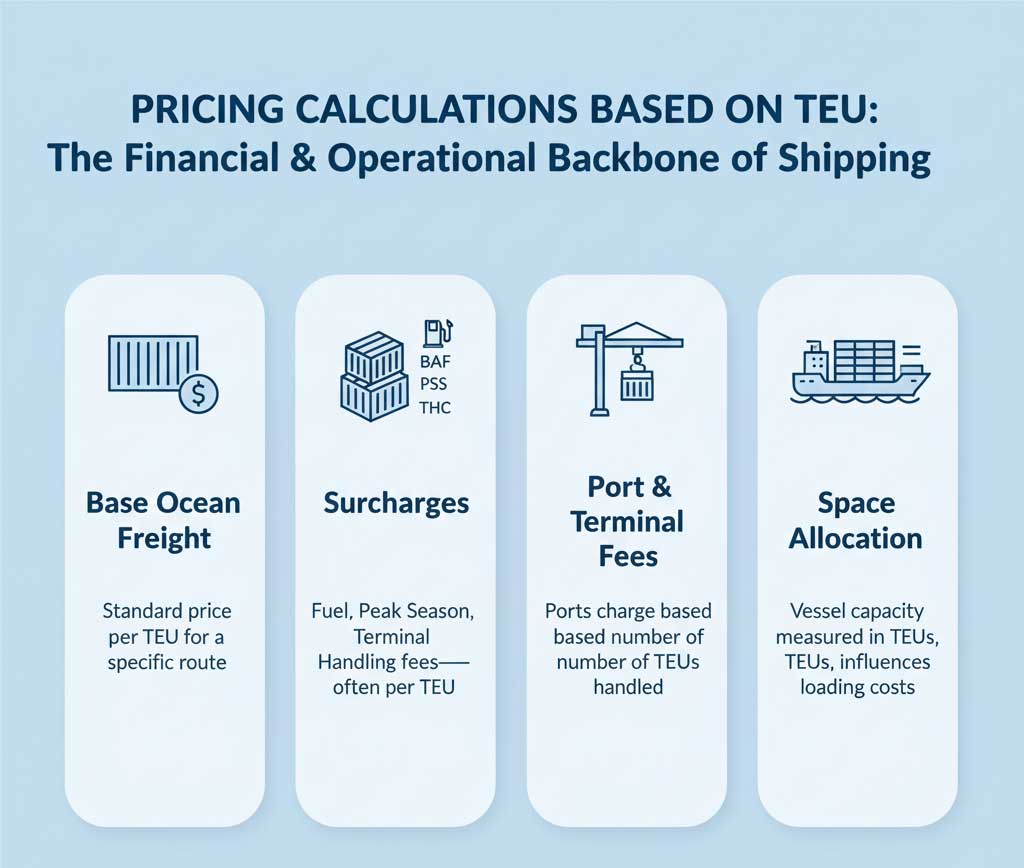
Pricing Calculations Based on TEU
Shipping lines and freight forwarders commonly use TEU-based calculations for:
- Base Ocean Freight: The standard price per TEU for a specific route.
- Surcharges: Including fuel adjustment (BAF), peak season surcharge (PSS), and terminal handling charges (THC), all often calculated per TEU.
- Port and Terminal Fees: Ports charge based on the number of TEUs handled.
- Space Allocation: Vessel capacity planning is measured in TEUs, influencing how many containers can be loaded and how costs are distributed.
In practice, TEU shipping rates allow businesses to compare ocean freight prices across carriers, shipping seasons, and global routes with consistency and transparency.
Factors That Influence TEU Rates
Several factors determine how much a shipper pays per TEU on any given route:
- Fuel Prices: Higher bunker fuel prices increase per-TEU costs.
- Port Congestion: Busy ports charge higher handling fees, increasing TEU shipping rates.
- Global Trade Demand: Peak seasons (e.g., pre-Chinese New Year) drive TEU rates up.
- Container Imbalance: Shortages or surpluses of empty containers affect TEU availability and pricing.
- Vessel Size and Capacity: Larger ships lower the cost per TEU through economies of scale.
- Route Distance and Risk: Longer or politically sensitive routes generally cost more per TEU.
These variables show why TEU shipping is dynamic,rates can change weekly based on global economic and supply chain conditions.
Advantages and Limitations of Using TEU
In global logistics and TEU shipping, using TEU as a standard measurement helps simplify communication between carriers, ports, and shippers. However, like any system, TEU has both strengths and limitations. Understanding these helps businesses plan shipments more accurately and avoid miscalculations in freight planning.
Benefits of a Standard Unit
Using TEU as a universal measurement brings several important advantages:
- Global Standardization: TEU allows ports, carriers, and freight forwarders to use a single reference point in reporting capacity and planning vessel loads.
- Simplified Cost Calculation: In TEU shipping, freight rates, terminal fees, and carrier surcharges are much easier to calculate using a consistent unit.
- Better Capacity Planning: Ships and ports can evaluate throughput based on TEUs handled, making infrastructure planning and cargo forecasting far more accurate.
- Easy Comparison: TEU makes it simple to compare container volumes across countries, shipping lines, and transport modes without complexity.
For global trade, TEU brings clarity and efficiency to a logistics landscape that would otherwise be far more fragmented.
Limitations and Challenges
Despite its benefits, TEU also has several limitations:
- Not All Containers Are Uniform: TEU represents a 20-ft container, but many shipments use 40-ft (FEU), high-cube, open-top, or other special containers that don’t perfectly align with TEU sizing.
- Weight Differences: A TEU does not show whether a container is light or heavy. Two TEUs may occupy equal space but have very different handling or safety requirements.
- Operational Misalignment: Some regions and terminals rely more heavily on FEUs, causing occasional inconsistencies in area usage or yard planning.
- Oversimplification: For certain cargo types, such as project cargo or tank containers, TEU measurement may not accurately reflect true capacity or cost.
These challenges show that while TEU is useful, it’s not always a perfect representation of real-world cargo demands..
Solutions and Industry Adaptations
The shipping industry has developed several solutions to overcome TEU’s limitations:
- Dual Measurement Systems: Many carriers now publish capacity in both TEU and FEU to give customers a clearer picture of vessel space.
- Advanced Port Software: Modern terminals use digital yard systems that calculate real container dimensions, not just TEU equivalents, improving planning accuracy.
- Cargo Weight Integration: Some shipping lines combine TEU measurement with weight metrics to better balance vessel safety and loading efficiency.
- Specialized Container Tracking: For reefer, tank, or oversized units, separate tracking and pricing systems complement TEU to provide a more precise cost estimate.
These adaptations ensure that TEU shipping remains efficient while compensating for the limitations of a single standard unit.
The Future of TEU in Global Maritime Trade
As global trade continues to expand, the concept of TEU remains central to TEU shipping and maritime logistics. However, the future of TEU is being shaped by digitalization, automation, sustainability goals, and the ongoing evolution of containerization. Understanding these trends helps businesses and shipping lines prepare for the next phase of global maritime trade.
Trends in Containerization
The world of containerization is rapidly evolving, and TEU continues to serve as the foundation of capacity measurement. Key trends include:
- Growth of Mega-Vessels: Shipping lines are deploying more ULCVs capable of carrying over 24,000 TEUs, reducing cost per container and increasing efficiency.
- Standardization Expansion: While TEU remains the core unit, new container types such as collapsible containers and lightweight materials,are influencing future standards.
- Regional Container Demand: Emerging markets in Africa, South America, and Southeast Asia are increasing their reliance on TEU shipping, boosting demand for feeder networks.
These trends show that TEU will remain the backbone of global container transport, even as container designs and logistics strategies evolve.
Technological Innovations and Automation
Technology is transforming the way TEU shipping operates. Some of the most important innovations include:
- Automated Port Terminals: Robotics, autonomous cranes, and automated guided vehicles (AGVs) reduce loading times and improve TEU handling accuracy.
- Smart Containers: IoT-enabled containers allow real-time tracking of location, temperature, humidity, and security data.
- Digital Documentation: Blockchain and e Bill of Lading systems make TEU shipping documentation faster, more secure, and error-free.
- AI-Based Voyage Optimization: Shipping lines increasingly use AI to optimize routes, reduce fuel consumption, and improve TEU capacity utilization.
These technologies enhance efficiency, reduce costs, and make global shipping more predictable and transparent.
Sustainability and Green Shipping Initiatives
Environmental concerns are reshaping global shipping, and TEU-based operations are no exception. Sustainability trends include:
- Green Fuels: LNG, methanol, ammonia, and future hydrogen-based fuels are reducing emissions per TEU transported.
- Energy-Efficient Vessels: New ship designs focus on fuel-efficient engines, eco-friendly hull coatings, and waste heat recovery systems to reduce CO₂ output.
- Carbon Accounting per TEU: Shipping lines now report emissions based on grams of CO₂ per TEU–kilometer, helping businesses track environmental impact.
- Shore Power & Port Electrification: Allow vessels to turn off engines while docked, lowering air pollution and improving sustainability metrics.
These initiatives show how the shipping industry is adapting TEU shipping to meet global carbon reduction goals and build a greener logistics future.
Final Thoughts
Understanding the concept of TEU is essential for anyone involved in global trade, logistics, or maritime transportation. As the universal unit for measuring container capacity, TEU simplifies communication, improves planning, and helps businesses estimate shipping costs with greater accuracy. From port operations to vessel design and freight pricing, TEU plays a central role in keeping the world’s supply chain efficient and connected.
As global commerce continues to expand, the importance of TEUand standardized containerization as a wholewill only grow stronger. Whether you are a shipper, freight forwarder, or simply curious about the logistics behind international shipping, knowing how TEU works gives you a clearer understanding of how goods move across the world every day.
Frequently Asked Questions (FAQ)
What is a TEU in shipping?
TEU stands for Twenty-foot Equivalent Unit, the standard measurement for container capacity.
How large is a TEU container?
A TEU is a 20-foot container with standard ISO dimensions.
What is the difference between TEU and FEU?
A FEU is a 40-foot container and equals 2 TEU.
How is TEU used in freight pricing?
Shipping rates are often calculated based on the number of TEUs you ship.
Why is TEU important in global logistics?
It provides a universal unit to measure ship capacity, port operations, and container volumes.
How many TEUs can large container ships carry?
Modern mega-vessels can carry more than 20,000 TEU.
Is TEU the same worldwide?
Yes,TEU follows international ISO standards used globally.
What types of cargo are shipped in TEU containers?
General dry cargo like electronics, clothing, machinery, and consumer goods.
How much weight can a TEU container hold?
Typically around 24,000 kg, depending on regulations and container design.
Do ports measure traffic in TEU?
Yes, TEU is the standard unit used to measure port throughput and container volume.








